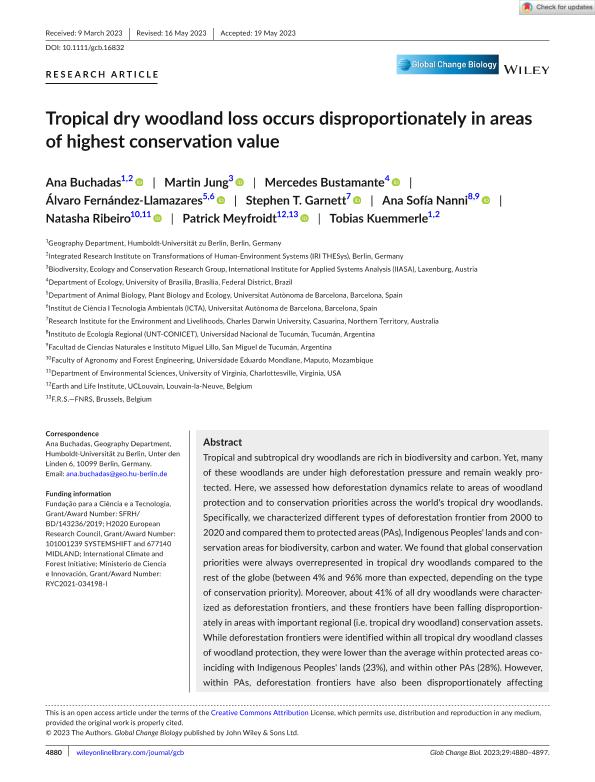Artículo
Tropical dry woodland loss occurs disproportionately in areas of highest conservation value
Buchadas, Ana; Jung, Martin; Bustamante, Mercedes; Fernández Llamazares, Álvaro; Garnett, Stephen T.; Nanni, Ana Sofía ; Ribeiro, Natasha; Meyfroidt, Patrick; Kuemmerle, Tobias
; Ribeiro, Natasha; Meyfroidt, Patrick; Kuemmerle, Tobias
 ; Ribeiro, Natasha; Meyfroidt, Patrick; Kuemmerle, Tobias
; Ribeiro, Natasha; Meyfroidt, Patrick; Kuemmerle, Tobias
Fecha de publicación:
09/2023
Editorial:
Wiley Blackwell Publishing, Inc
Revista:
Global Change Biology
ISSN:
1365-2486
Idioma:
Inglés
Tipo de recurso:
Artículo publicado
Clasificación temática:
Resumen
Tropical and subtropical dry woodlands are rich in biodiversity and carbon. Yet, many of these woodlands are under high deforestation pressure and remain weakly protected. Here, we assessed how deforestation dynamics relate to areas of woodland protection and to conservation priorities across the world´s tropical dry woodlands. Specifically, we characterized different types of deforestation frontier from 2000 to 2020 and compared them to protected areas (PAs), Indigenous Peoples´ lands and conservation areas for biodiversity, carbon and water. We found that global conservation priorities were always overrepresented in tropical dry woodlands compared to the rest of the globe (between 4% and 96% more than expected, depending on the type of conservation priority). Moreover, about 41% of all dry woodlands were characterized as deforestation frontiers, and these frontiers have been falling disproportionately in areas with important regional (i.e. tropical dry woodland) conservation assets. While deforestation frontiers were identified within all tropical dry woodland classes of woodland protection, they were lower than the average within protected areas coinciding with Indigenous Peoples´ lands (23%), and within other PAs (28%). However, within PAs, deforestation frontiers have also been disproportionately affecting regional conservation assets. Many emerging deforestation frontiers were identified outside but close to PAs, highlighting a growing threat that the conserved areas of dry woodland will become isolated. Understanding how deforestation frontiers coincide with major types of current woodland protection can help target context-specific conservation policies and interventions to tropical dry woodland conservation assets (e.g. PAs in which deforestation is rampant require stronger enforcement, inactive deforestation frontiers could benefit from restoration). Our analyses also identify recurring patterns that can be used to test the transferability of governance approaches and promote learning across social–ecological contexts.
Archivos asociados
Licencia
Identificadores
Colecciones
Articulos(IER)
Articulos de INSTITUTO DE ECOLOGIA REGIONAL
Articulos de INSTITUTO DE ECOLOGIA REGIONAL
Citación
Buchadas, Ana; Jung, Martin; Bustamante, Mercedes; Fernández Llamazares, Álvaro; Garnett, Stephen T.; et al.; Tropical dry woodland loss occurs disproportionately in areas of highest conservation value; Wiley Blackwell Publishing, Inc; Global Change Biology; 29; 17; 9-2023; 4880-4897
Compartir
Altmétricas



